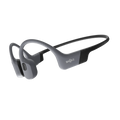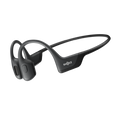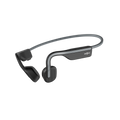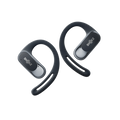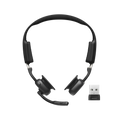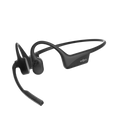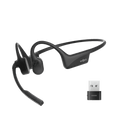
Thinking about purchasing a wireless headset? Not really sure how it works? You’re not the only one. Bluetooth is everywhere these days, but even those who already have wireless speakers, wireless keyboards, even wireless pens, don’t always understand what Bluetooth technology is or how it’s allowing them to locate their car keys. This article explains everything you’ve ever wanted to know about Bluetooth...and probably a little more.
What is Bluetooth?
Bluetooth is a low-power wireless technology that can be used to connect two electronic devices between short distances. What constitutes a short distance? Most Bluetooth devices max out at 33 feet.
Some people confuse Bluetooth and Wifi. Though they’re both wireless technologies, they fulfill different purposes. While Bluetooth is used to connect two devices to each other, Wifi is used to connect a device to the internet. You can use Bluetooth without Wifi, and you can use Wifi without Bluetooth.
Bluetooth also shouldn’t be confused with infrared - the technology in your TV remote. An infrared signal cannot transmit through a physical obstruction, while a Bluetooth signal can.
How Does Bluetooth Work?
All Bluetooth devices contain a microchip with an antenna that allows it to communicate with other Bluetooth devices. Both devices need to be Bluetooth enabled in order for a connection to be made.
Think of Bluetooth as an imaginary bridge between one electronic device and the other. In order for this connection to be established, both devices need to have a few things in common. They need to communicate on the same radio frequency and they need to speak the same language, referred to as a protocol. This protocol sets a standard for how much information is transferred between the two devices and when. Once a connection is made, Bluetooth can then be used to stream music, upload data, or broadcast information.
Types of Bluetooth Connections
Most wireless headphones including AfterShokz use what’s referred to as a one-to-one connection, meaning that one device is paired to another device, and additional devices cannot be added without breaking the connection with the first. Even Trekz Titanium’s multipoint pairing feature just bounces back and forth between two different one-to-one connections.
But there are other types of Bluetooth connections. A broadcast connection allows for one Bluetooth device to transmit its signal to many different devices, and a mesh connection allows for many devices to connect with many other devices.
Bluetooth Power Classes
In addition to the different types of Bluetooth connections, Bluetooth microchips come in three different power classes. Class 3 is the least powerful class with a range of only a few feet. Not too many devices use this power class. On the opposite side of the spectrum is Class 1, the most powerful class offering a range of over 300 feet. Not too many devices have this power class either. Right in the middle is Class 2, which is what you’ll find in most Bluetooth devices including AfterShokz headphones. Class 2 offers a range of up to 33 feet.
The Benefits of Bluetooth
Why choose a Bluetooth product? One of the most obvious benefits is that it eliminates the use of wires and cords. Headphones are less restrictive and more comfortable. Computer keyboards are more visually appealing. You can upload photos from your camera or data from your fitness tracker without having to pull out a plug.
Because Bluetooth is a low-power technology, it also doesn’t require a lot of energy, so using your wireless headphones with your phone for example won’t drain either device.
Bluetooth is also affordable and fairly simple to use.
Any Downside?
So what cons come with Bluetooth? Like all technology, it’s not 100% perfect all the time. You may have a day where it takes an extra minute for your devices to connect, or you may find your devices disconnected for no apparent reason. But Bluetooth connectivity issues are almost always a quick fix!
While it won’t drain your battery, Bluetooth still uses some battery, something most wired products won’t do.
The Future of Bluetooth
Bluetooth was created in 1994 and it’s here to stay. This year we saw the release of Bluetooth 5 with capabilities that blew previous Bluetooth versions out of the park with a faster speed, increased broadcast capacity, and a range that peaks at 1,000 feet! While most devices haven’t made the switch to this version yet, you can expect to see a lot more of it in the future.

